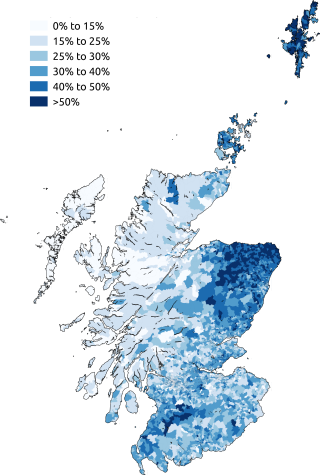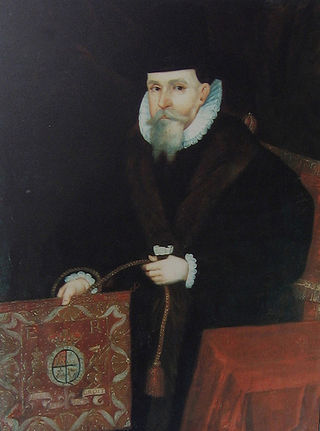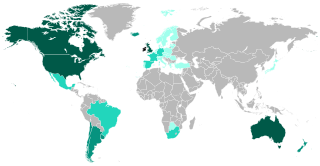Related Research Articles
The Goidelic or Gaelic languages form one of the two groups of Insular Celtic languages, the other being the Brittonic languages.

Anne was Queen of Great Britain and Ireland following the ratification of the Acts of Union on 1 May 1707, which merged the kingdoms of Scotland and England. Before this, she was Queen of England, Scotland, and Ireland from 8 March 1702.

Scots is an Anglic language variety in the West Germanic language family, spoken in Scotland and parts of Ulster in the north of Ireland. Most commonly spoken in the Scottish Lowlands, Northern Isles, and northern Ulster, it is sometimes called Lowland Scots to distinguish it from Scottish Gaelic, the Goidelic Celtic language that was historically restricted to most of the Scottish Highlands, the Hebrides, and Galloway after the sixteenth century; or Broad Scots to distinguish it from Scottish Standard English. Modern Scots is a sister language of Modern English, as the two diverged independently from the same source: Early Middle English (1100–1300).

In Gaelic myth, the Cailleach is a divine hag and ancestor, associated with the creation of the landscape and with the weather, especially storms and winter. The word literally means 'old woman, hag', and is found with this meaning in modern Irish and Scottish Gaelic, and has been applied to numerous mythological and folkloric figures in Ireland, Scotland, and the Isle of Man. In modern Irish folklore studies, she is sometimes known as The Hag of Beara, while in Scotland she is known as Beira, Queen of Winter.

Adam Loftus was an English Anglican bishop who was Archbishop of Armagh, and later Dublin, and Lord Chancellor of Ireland from 1581. He was also the first Provost of Trinity College Dublin.

Atholl or Athole is a large historical division in the Scottish Highlands, bordering Marr, Badenoch, Lochaber, Breadalbane, Strathearn, Perth, and Gowrie. Historically it was a Pictish kingdom, becoming one of the original provinces of the Kingdom of Alba before being incorporated into the sheriffdom and later county of Perthshire. Today it forms the northern part of Perth and Kinross, Scotland.

Irish people are an ethnic group and nation native to the island of Ireland, who share a common ancestry, history and culture. There have been humans in Ireland for about 33,000 years, and it has been continually inhabited for more than 10,000 years. For most of Ireland's recorded history, the Irish have been primarily a Gaelic people. From the 9th century, small numbers of Vikings settled in Ireland, becoming the Norse-Gaels. Anglo-Normans also conquered parts of Ireland in the 12th century, while England's 16th/17th century conquest and colonisation of Ireland brought many English and Lowland Scots to parts of the island, especially the north. Today, Ireland is made up of the Republic of Ireland and Northern Ireland. The people of Northern Ireland hold various national identities including British, Irish, Northern Irish or some combination thereof.

Ogham is an Early Medieval alphabet used primarily to write the early Irish language, and later the Old Irish language. There are roughly 400 surviving orthodox inscriptions on stone monuments throughout Ireland and western Britain, the bulk of which are in southern Munster. The largest number outside Ireland are in Pembrokeshire, Wales.

The Bowes-Lyon family descends from George Bowes of Gibside and Streatlam Castle (1701–1760), a County Durham landowner and politician, through John Bowes, 9th Earl of Strathmore and Kinghorne, chief of the Clan Lyon. Following the marriage in 1767 of the 9th Earl to rich heiress Mary Eleanor Bowes, the family name was changed to Bowes by Act of Parliament. The 10th Earl changed the name to Lyon-Bowes and the 13th Earl, Claude, changed the order to Bowes-Lyon.
Galwegian Gaelic is an extinct dialect of Scottish Gaelic formerly spoken in southwest Scotland. It was spoken by the people of Galloway and Carrick until the early modern period. Little has survived of the dialect, so that its exact relationship with other Gaelic language is uncertain.
Forbhlaith was the latter of two heiresses of Atholl, the other being her sister Isabella. She married David de Hastings, a French knight who already possessed minor lands in Angus. They were, however, without a son when David died in 1247. They were succeeded by their daughter Ada.
Béḃinn or Bé Binn, in modern orthography Béibhinn, is an early Irish personal and mythological name. In some sources Béḃinn is a goddess associated with birth and the sister of the river-goddess, Boann. Béḃinn is also described as being an underworld goddess in both Irish and Welsh mythology, inhabiting either the Irish underworld Mag Mell or the Welsh Annwn, although it is unknown which is the original source.

The High Middle Ages of Scotland encompass Scotland in the era between the death of Domnall II in 900 AD and the death of King Alexander III in 1286, which was an indirect cause of the Wars of Scottish Independence.

The languages of Scotland belong predominantly to the Germanic and Celtic language families. The main language now spoken in Scotland is English, while Scots and Scottish Gaelic are minority languages. The dialect of English spoken in Scotland is referred to as Scottish English.

Mary is a feminine given name, the English form of the name Maria, which was in turn a Latin form of the Greek name Μαρία, María or Μαριάμ, Mariam, found in the Septuagint and New Testament. The latter reflects the original Hebrew pronunciation of the name מרים, as attested by the Septuagint. The vowel "a" in a closed unaccented syllable later became "i", as seen in other names such as "Bil'am" (Balaam) and "Shimshon" (Samson).

Irish, also known as Irish Gaelic or simply Gaelic, is a Goidelic language of the Insular Celtic branch of the Celtic language group, which is a part of the Indo-European language family. Irish is indigenous to the island of Ireland and was the population's first language until the 19th century, when English gradually became dominant, particularly in the last decades of the century. Today, Irish is still commonly spoken as a first language in areas of Ireland collectively known as the Gaeltacht, in which only 2% of Ireland's population lived in 2022.
Common Brittonic, also known as British, Common Brythonic, or Proto-Brittonic, is an extinct Celtic language spoken in Britain and Brittany.

Sean, also spelled Seán or Séan in Hiberno-English, is a masculine given name of Irish origin. It comes from the Irish versions of the Biblical Hebrew name Yohanan, Seán and Séan, rendered John in English and Johannes/Johann/Johan in other Germanic languages. The Norman French Jehan is another version.
References
- ↑ eDIL - Dictionary of the Irish Language Letter F, Column 335
- ↑ Forbflaith: MedievalScotland.org
- ↑ Sheard, K. M. (2011), Llewellyn’s Complete Book of Names , p. 225, at Google Books, p. 225, ISBN 9780738723686.